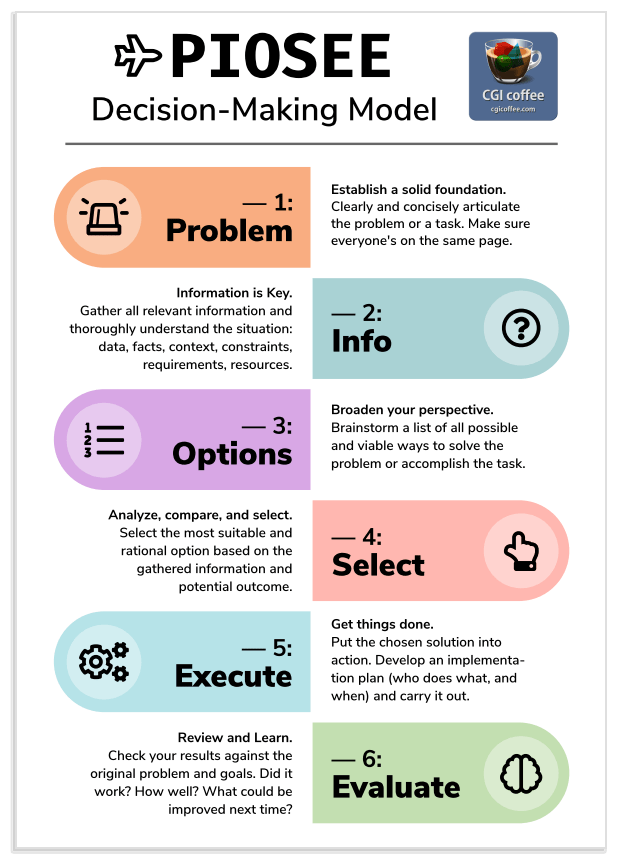The time has come…
Time share a valuable piece of insight, something I've relied on for several years now and use almost instinctively for problem-solving and decision-making. I’m confident you'll also find it useful in your work and personal life. It's called…
✈ PIOSEE
Allow me to elaborate.
✈ PIOSEE is a decision-making model which stands for:
- Problem
- Information
- Options
- Select
- Execute
- Evaluate
What makes it special is that P➡I➡O➡S➡E➡E is a sequence of actions that airplane pilots follow when making decisions. It's especially useful in complex, stressful, high-stakes situations where lives are on the line, is incredibly effective for planning, brainstorming, and can be applied in discussions.
It allows to systematically move from defining a problem to choosing the best course of action and implementing it. It's well-suitable when there are several possible paths or differing opinions, with a high chance of disagreement. Therefore, this model can even help mitigate conflicts by guiding the conversation towards a more rational state, where emotions are less likely to take over, because the brain responds well to facts, and when presented with rational arguments, it naturally steers towards a logical response, rather than an emotional one.
All in all, in case you're looking for a simple and versatile approach to problem-solving, look no further.
✈ PIOSEE How-To
Breakdown of the Steps:
- P (Problem) – Establish a solid foundation:
- What to do: Clearly and concisely articulate the problem that needs solving or the task that needs doing. Make sure everyone's on the same page (if working with a team). If there's a misunderstanding, help identify the cause and resolve it.
- Why it's important: Without a clear understanding of the problem, you risk wasting time and resources, or making it worse.
- I (Information/Investigation) – Gather Information:
- What to do: Collect all available and relevant information: data, facts, context, constraints, requirements, resources. Study the current situation thoroughly. Approach it methodically, ensuring you clearly understand what you're dealing with.
- Why it's important: To ensure that subsequent steps (like choosing options and execution) are based on facts and knowledge, not assumptions.
- O (Options) – Broaden your perspective:
- What to do: Brainstorm a list of all possible ways to solve the problem or accomplish the task. Don't dismiss or criticize any ideas at this stage! That can be a significant mistake. Often, even unconventional ideas can prove valuable when combined with others or when they spark an entirely new approach.
- Why it's important: To consider various approaches, and increase your chances of finding the optimal solution.
- S (Select) – Choose the Best Option:
- What to do: Analyze and compare the Options generated. Use the Information gathered and your clear understanding of the Problem to select the most suitable and rational option. An evaluation criteria can be applied here to help rate the options, even if not explicitly a separate step.
- Why it's important: To make a conscious, well-founded decision, committing to a specific course of action.
- E (Execute) – Implement the Solution:
- What to do: Put the chosen solution into action. Develop an implementation plan (who does what, and when) and carry it out.
- Why it's important: To get things done in a timely and orderly fashion.
- E (Evaluate) – Assess the Outcome:
- What to do: Analyze the results of your Execution. Compare the outcome against the initial Problem and any stated goals. Did your actions resolve the problem? How effectively? What could have been done better?
- Why it's important: To complete the feedback loop! This helps you understand if the solution was effective, learn lessons for the future, and, if necessary, adjust your approach (which might involve revisiting earlier steps).
Why Use This Model Specifically?
- Complete Cycle: This approach covers the entire process, from "What happened?" to "What were the results of our actions and why?"
- Structure and Objectivity: It helps prevent chaos, promotes systematic action, and encourages reliance on information for decision-making, rather than just intuition or a random advice.
- Transparency and Communication: All stages are clear, which facilitates discussion, ensures everyone is on the same page, and minimizes the potential for conflict. Because you know what a "conflict" is? It's a mismatch of expectations. Simple as that. When everyone has the same information and understands the course of action, as well as the expected outcome, without external variables introduced, no conflict can take place. Seek to avoid conflict, and you will achieve harmony. Wow, that's deep, lol.
- Emphasis on Results: The explicit "Evaluate" step encourages you to analyze the outcomes of your work, rather than just completing a task and forgetting it. This is paramount for improvement!
- Flexibility: The evaluation at the end allows you to determine if changes are needed, if a new cycle should begin, or if the task was successfully resolved. If you need to address it again, you can restart PIOSEE, this time equipped with new knowledge for the Information and Options stages. It's effectively an iterative process. More on this below.

After relying on it in my personal and work life for several years, I can vouch that PIOSEE is a remarkably effective approach to problem-solving. Many similar concepts and models exist, but in my experience, most of them either don't always align with what cause-and-effect-based logic would suggest, or are just overly complicated for no reason. PIOSEE, on the other hand, simulates how the human brain tends to work. Look up "cognitive psychology" if you have some free time to discover one of the more scientific attempts at explaining how the human brain functions.
An Unconventional Example
PIOSEE is effective even when the "problem" isn't as much a problem, but rather a goal or a creative task. Check out my recent article on Alt code emulation with TKL keyboards. It also follows the PIOSEE model because it was literally expanded upon from the following quick "draft":
P
- my retro kb
- no rollover, need a gaming wireless kb
- zoomer kbs with no numpad lol, need special chars
I
- what TKLs are
- why use numpad for codes?
O
- registry changing software
- that trivial capslock idea from that post, failed
- or portable ahk script
S
- why script is better imo
- maybe fit in the unix way nag?
E
- post code (latest ver)
- explanation and faq
E
- can be made better
- other ways to enter specials
- some cool facts maybeIf you follow my blog or decide to check out some of more popular posts of mine (see the full list here), you'll quickly notice that many of those are structured more or less in accordance with the PIOSEE model. Once you see it or try it yourself, you'll never be able to "unsee" or forget it. And over time it will become second nature.
PIOSEE For Learning and Improvement
Finally, since this approach is systematic, the results are measurable, which can greatly help you improve by analyzing them. So it can and should be considered a "recursive" strategy.
In my example, the resulting article can be seen as a "sub-task" located within the "Evaluate" step. Here I would try my best to objectively analyze the results. And you, my dear reader, are the final recipient of this work, the observer, who always exists at the "Evaluate" stage, to either learn from my experiences or provide feedback. If you choose to reach me with your criticism and I find it reasonable, I'll simply rewind the article back to the P-I-O-S stage and iterate on it, but this time — taking the new information and corrections into consideration.
This is the foundation for an iterative approach to continuous improvement. Even for quick decisions, mentally walking through these steps — especially P-I-O-S — helps structure your thoughts. Whilst including E-E (Execute-Evaluate) ensures that the decision is followed through and analyzed.
tl;dr
Just try this out, OK? It works and is easy to remember.
✈ PIOSEE PDF Cheat Sheet
Finally, as promised in the title of the post, I made a PDF Cheat Sheet you can download.
I implore you to try and put this guide into practice. The key is to genuinely try applying it, both in your professional and personal life, on your own or in team projects. I promise, you'll appreciate how much it can steam-line decision-making.

